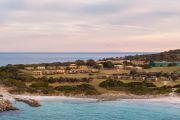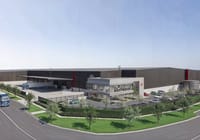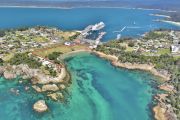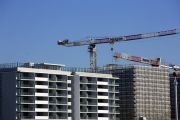
No trains or passengers yet, but Melbourne’s new Metro Rail has shops
Melbourne’s $15.5 billion Metro Rail may not have an opening date, but the operator of the five-station underground train line is lining up coffee shops, convenience stores and sushi retailers for passengers when they finally do make it through the turnstiles.
Cross Yarra Partnership, the consortium tasked with delivering and operating the train stations, has leased 60 per cent of the almost-4000 square metres of retail space in the stations to brands including IGA, People’s Coffee, Sushi Sushi, Starbucks, KFC and 7-Eleven.

“When the Metro Tunnel opens in 2025, it will transform how commuters, visitors and shoppers engage with the city,” said Aoife Kealy, the consortium’s director of commercial development and services.
It’s done that already in Sydney, where the metro line that opened in August has slashed the time taken to get between locations such as North Sydney and the Martin Place CBD.
In Melbourne’s case, the project initially due for completion last month, then extended to June – and which now has no confirmed end date – will connect lines from Sunbury in the west through the CBD with those to Cranbourne and Pakenham in the southeast. That creates a whole new market of shoppers.
Nine-kilometre twin tunnels will connect Arden Station in North Melbourne and Parkville Station near the city’s largest hospitals and University of Melbourne, with separate State Library and Town Hall stations on Swanston Street and Anzac Station in the Domain precinct of St Kilda Road.
They collectively account for 37 individual tenancies that are likely to be consolidated into 27, with Parkville and Town Hall having the most, at about 13 each, with four in each of the others.

Town Hall has been the most popular location among prospective tenants, followed by Parkville – where the retail arcade crossing under Royal Parade features an artwork by Patricia Piccinini – said Tom Larwill, commercial agency Colliers’ associate director of retail leasing, who declined to quantify rents.
“The strength of the project is the locations of them, in prime hubs … and being part of that commuter hub is incredibly important,” Mr Larwill said.
“It brings more people in more frequently and the opportunity that retailer sees – you’re the first and last shop these guys see before they leave the CBD, or Anzac, or Arden. That’s the benefit they’re seeing.”
The Victorian government’s projections – made in 2016 – are that Anzac Station would be used by 36,000 people each day in 2031 and Parkville would be used by nearly 60,000 people each day. Colliers puts the total at more than 275,000 across the five stations daily.
Retail leasing, however, was not just a way to bring in revenue from the station assets, Ms Kealy said.
The choice of tenants and their operating agreements also played a role in keeping the cavernous spaces – as deep as 40 metres underground at the State Library Station – safe, she said.

“Not only is retail great to service the commuters and local community, it adds that passive surveillance and activation,” Ms Kealy said.
“You’re more likely to take a train late at night on your own if the shops are open when you hop off the train.”
The stations will be open from 4am till midnight and the Starbucks and 7-Eleven tenancies will operate for those full periods, Ms Kealy said.
As with the experience of Sydney Metro, which opened in August – and has opened up the harbour city to a new fast-rail experience – the challenge was to match retail to the character of the different stations and the communities they would serve.
But it’s not immediate. Outside North Sydney’s Victoria Cross station, Lendlease – part of the Cross Yarra Partnership – aims to curate the retail precinct to cater both for workday commuters and weekend residents in the civic precinct.
So far, however, the shops that have opened only serve the takeaway and commuter crowds and not the more leisurely market. An 18-hour daily activation around the station would only happen when its planned 40-storey, over-station commercial tower was complete, said Lendlease’s head of development Tom Mackellar.

“We expect the precinct will get another boost next year when we launch more formal, sit-down dining options alongside our tower,” Mr Mackellar said.
Back in Melbourne, while all stations have the same architects – Hassell with London-based Weston Williamson + Partners and RSHP – the retail will differ by location.
Anzac Station on the city’s southern edge, for example, will have a retail kiosk above ground on the connected tram stop, as well as a 7-Eleven, retailer and a food-and-beverage operator underground, Ms Kealy said.
Fast-food operator KFC will go into the Town Hall and Parkville stations.
“KFC is not going into Anzac,” she said. “They are responding to the demographic.”
Arden Station will be the only one able to have a boutique pizza operator because it was the only station where the retail concessions were above ground level, Ms Kealy said.
“We haven’t been able to have wood-fired pizza or flames underground but in Arden we can,” she said.











